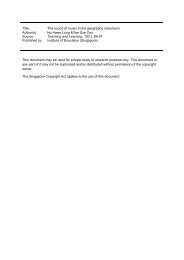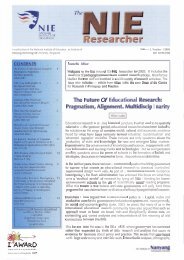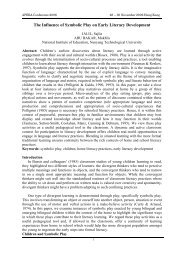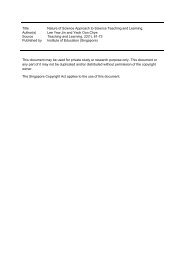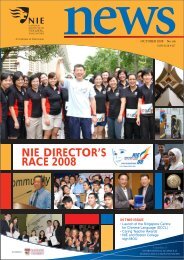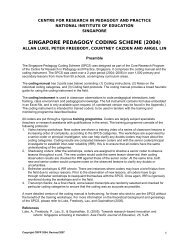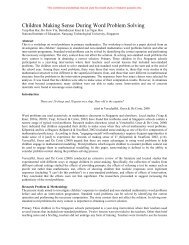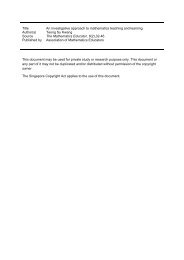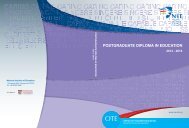Learning in and for the 21st Century - NIE Digital Repository
Learning in and for the 21st Century - NIE Digital Repository
Learning in and for the 21st Century - NIE Digital Repository
You also want an ePaper? Increase the reach of your titles
YUMPU automatically turns print PDFs into web optimized ePapers that Google loves.
SYMPOSIUM <strong>and</strong> PUBLIC LECTURE<br />
Questions & Answer sessions<br />
Professor JOHN SEELY BROWN<br />
21–22 November 2012<br />
learn<strong>in</strong>g. Not everybody is a Google or have <strong>the</strong><br />
resources to do those th<strong>in</strong>gs. Where do you see<br />
companies go<strong>in</strong>g with try<strong>in</strong>g to harness that tacit<br />
knowledge <strong>and</strong> perhaps not hav<strong>in</strong>g employees<br />
– valuable employees – walk away with that tacit<br />
knowledge<br />
not watch television anymore. What <strong>the</strong>y do is that<br />
<strong>the</strong>y watch YouTube. Now, <strong>the</strong>y are already watch<strong>in</strong>g<br />
all sorts of YouTube videos <strong>and</strong> discuss<strong>in</strong>g <strong>the</strong>m. With<br />
YouTube, you are pull<strong>in</strong>g <strong>in</strong><strong>for</strong>mation on dem<strong>and</strong>, <strong>and</strong><br />
talk<strong>in</strong>g about th<strong>in</strong>gs that you have become curious<br />
about.<br />
JSB: Sure. By <strong>the</strong> way, <strong>the</strong> only way you are go<strong>in</strong>g<br />
to keep talent from walk<strong>in</strong>g away is if you can create<br />
a context that makes <strong>the</strong>m stay. This is actually a<br />
very serious comment, but we do not th<strong>in</strong>k this way <strong>in</strong><br />
terms of talent management. Instead, we th<strong>in</strong>k about<br />
<strong>in</strong>creas<strong>in</strong>g bonuses <strong>and</strong> th<strong>in</strong>gs like that. We do not<br />
th<strong>in</strong>k about why kids stay <strong>in</strong> certa<strong>in</strong> places, which is<br />
because <strong>the</strong>y are learn<strong>in</strong>g more <strong>the</strong>re than <strong>in</strong> any o<strong>the</strong>r<br />
places.<br />
Regard<strong>in</strong>g <strong>the</strong> beg<strong>in</strong>n<strong>in</strong>g part of your question, I believe<br />
YouTube is an amaz<strong>in</strong>gly effective way to capture tacit<br />
knowledge. This regards a topic that I talked about<br />
a year ago here. This may seem ra<strong>the</strong>r strange but<br />
I studied champion big-wave surfers. And I can show<br />
you that today, a new move of a champion surfer will<br />
circulate around <strong>the</strong> entire globe <strong>in</strong> 48 hours. I would<br />
like you to know that a move <strong>in</strong> surf<strong>in</strong>g is a 100% tacit.<br />
What <strong>the</strong>se kids are do<strong>in</strong>g is that <strong>the</strong>y collaborate on<br />
deconstruct<strong>in</strong>g <strong>the</strong>se videos hours after <strong>the</strong>y start<br />
circulat<strong>in</strong>g around, <strong>the</strong>n try to work out <strong>the</strong> body moves<br />
– motions <strong>and</strong> rhythms – <strong>in</strong> <strong>the</strong>se videos. I could not<br />
believe that this k<strong>in</strong>d of tacit knowledge could be<br />
captured so easily <strong>and</strong> be circulated around <strong>the</strong> world<br />
so quickly. It got me th<strong>in</strong>k<strong>in</strong>g about ways to look at how<br />
we could capture <strong>the</strong> visualisations of practice, select<br />
<strong>the</strong> key moments out <strong>and</strong> <strong>the</strong>n try to deconstruct <strong>the</strong>m<br />
<strong>in</strong>dividually or collaboratively. This is a major start to<br />
be<strong>in</strong>g able to capture <strong>and</strong> share tacit knowledge.<br />
We have also just done a contextual study, talk<strong>in</strong>g to<br />
20-year-old students. We are f<strong>in</strong>d<strong>in</strong>g out that <strong>the</strong>y do<br />
There<strong>for</strong>e, I th<strong>in</strong>k we are at <strong>the</strong> verge where our kids<br />
have already figured out someth<strong>in</strong>g that we <strong>in</strong> <strong>the</strong><br />
corporate world are just beg<strong>in</strong>n<strong>in</strong>g to discover.<br />
Audience member 2: I am just curious to f<strong>in</strong>d out how<br />
you arrive at <strong>the</strong> doma<strong>in</strong>s that make up <strong>the</strong> dispositions<br />
of entrepreneurial learners.<br />
The second po<strong>in</strong>t is a comment. We educators<br />
are tra<strong>in</strong>ed <strong>in</strong> <strong>the</strong> 20th century skills <strong>and</strong> you are<br />
suggest<strong>in</strong>g that with regards to play <strong>and</strong> imag<strong>in</strong>ation,<br />
teachers need to be equipped, <strong>and</strong> <strong>the</strong>y need to<br />
consider how <strong>the</strong>y are go<strong>in</strong>g to be equipped to tra<strong>in</strong><br />
<strong>the</strong>se students. I th<strong>in</strong>k it could be <strong>the</strong> o<strong>the</strong>r way around<br />
– <strong>the</strong> students are teach<strong>in</strong>g <strong>the</strong> teachers.<br />
JSB: Let me respond to your comment first. My answer<br />
<strong>for</strong> you is <strong>the</strong> same as that <strong>for</strong> <strong>the</strong> corporate world. We<br />
are so used to th<strong>in</strong>k<strong>in</strong>g that we are <strong>the</strong> mentors <strong>for</strong> new<br />
staff that we do not th<strong>in</strong>k about reverse mentorship.<br />
However, I th<strong>in</strong>k that <strong>in</strong> a lot of situations, reverse<br />
mentorship <strong>and</strong> mentorship happen simultaneously.<br />
For example, <strong>the</strong> <strong>in</strong>quiry method can be problematic<br />
<strong>in</strong> <strong>the</strong> school system. Often, a situation arises when<br />
a kid asks a question <strong>and</strong> teacher has no idea how to<br />
answer that question. (By <strong>the</strong> way, we can answer most<br />
questions kids ask, assum<strong>in</strong>g we have PhDs!) But,<br />
what is <strong>the</strong> chance of be<strong>in</strong>g able to sit down <strong>and</strong> say,<br />
“Look, we’ve got <strong>the</strong> tools here. Let’s work toge<strong>the</strong>r<br />
to figure out <strong>the</strong> answer.” Yet, when you do so, you<br />
might f<strong>in</strong>d that <strong>the</strong> kid is better at navigat<strong>in</strong>g to f<strong>in</strong>d out<br />
answers, while you are much better at critiqu<strong>in</strong>g if <strong>the</strong><br />
answers are believable.<br />
<strong>Learn<strong>in</strong>g</strong> <strong>in</strong> <strong>and</strong> <strong>for</strong> <strong>the</strong> <strong>21st</strong> <strong>Century</strong><br />
29



